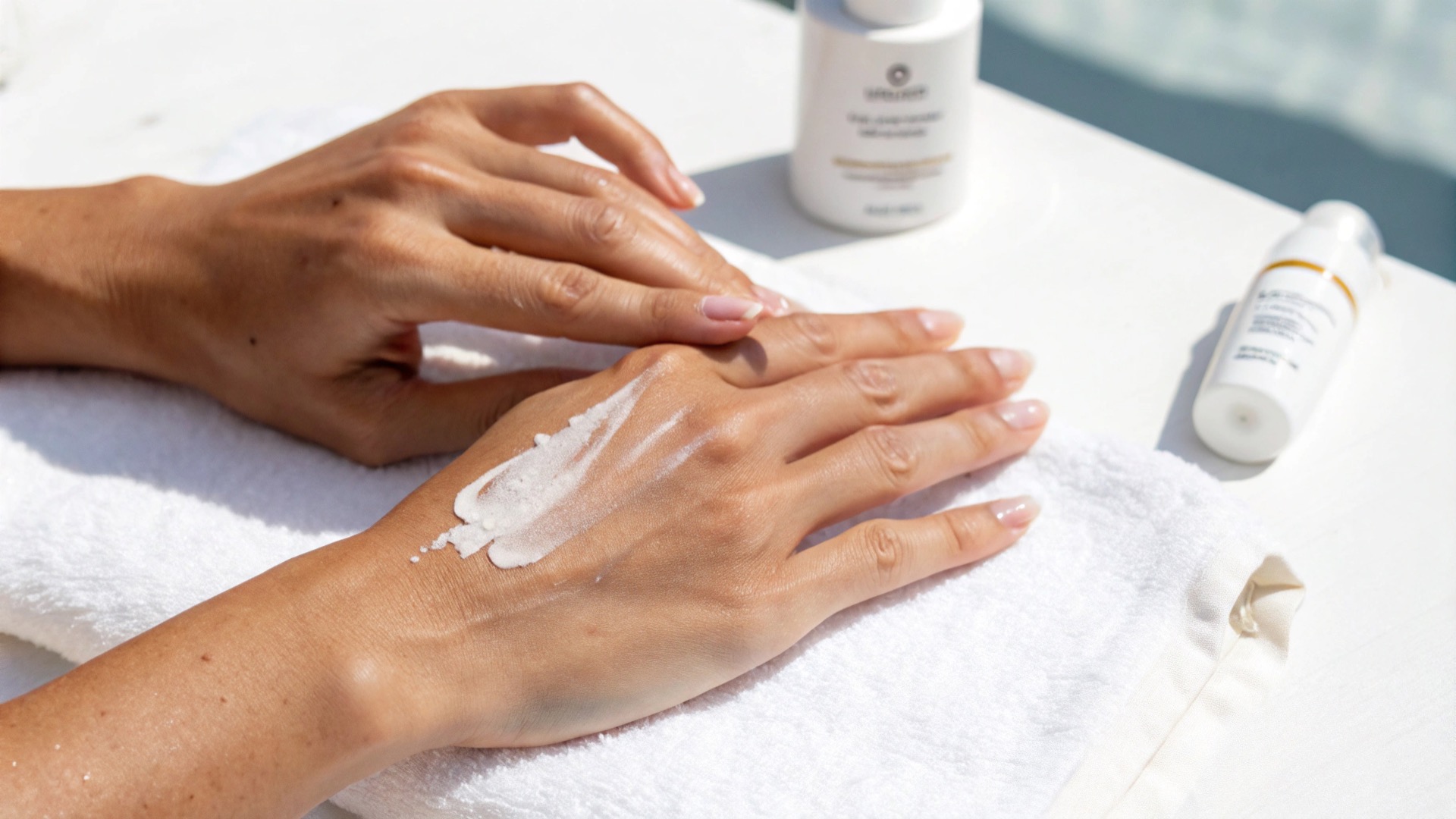Key takeaways
- Exosomes are tiny messengers that help cells communicate, creating a healthier environment that supports better function and even healing.
- Exosome therapy shows promise for skin rejuvenation, hair restoration, and regenerative medicine. FDA approval is limited – most treatments are considered experimental.
- Japan is currently the only country offering exosome therapy under flexible regulations, making it a global destination for treatment. Although the risks are minimal, they include infection, allergic reactions, and regulatory concerns.
Overview
Ever wonder why some people seem to age more gracefully than others? Or why do certain wounds heal faster? The answer might be floating around inside you right now.
While you’ve been scrolling through endless skincare routines and hair growth hacks, scientists have uncovered something incredible: your cells have been running their sophisticated repair network all along. And it’s a thousand times more precise than anything we’ve created in labs.
These microscopic repair specialists are called exosomes, and they’re now being turned into therapies that could change how we think about aging, hair loss, and healing. But here’s the big question everyone’s asking: Does exosome therapy actually work, or is it just expensive hype?
If you’ve seen celebrities raving about exosome treatments or noticed your dermatologist suddenly offering them, you’re not alone. Search interest has exploded, but behind all the Instagram posts and marketing buzz lies some genuinely fascinating science, and a few important things you need to know before diving in.
Let’s cut through the noise and get you the real story on what exosomes are, how exosome therapy works, and whether the science backs up those bold claims.
[PICTURE]
What are exosomes?
Exosomes are small structures released by every cell in your body and by nearly all living things, including humans, animals, plants, and even microbes. Think of them as biological text messages; they carry important information from one cell to another, helping coordinate healing, growth, and repair throughout your tissues.
Plant-derived exosomes are also being studied for their unique properties and potential applications, offering contrasts to exosomes from animal cells in terms of biogenesis, composition, and immunogenicity.
These microscopic vesicles contain a potent cocktail of:
- Proteins that trigger cellular responses
- RNA molecules that provide genetic instructions
- Growth factors that stimulate tissue repair
- Lipids that protect and deliver the cargo
Unlike larger cellular structures, exosomes are incredibly small, about 1,000 times smaller than the width of a human hair. This tiny size allows them to easily travel through your bloodstream and penetrate tissues that larger molecules cannot reach.
How do exosomes work in our body?
Here’s the fascinating process:
- Origin: Cells package their most important signals into exosome “parcels.”
- Release: These parcels are secreted into the surrounding tissues.
- Travel: Exosomes circulate through blood, lymph, and other body fluids.
- Delivery: They find target cells and deliver their healing cargo.
- Action: Recipient cells use the information to repair, regenerate, or function better.
This natural communication system becomes less efficient as we age, which is why researchers are excited about supplementing it through exosome therapy.
What is the difference between exosomes and stem cell-derived exosomes?
While both are involved in healing, they’re entirely different. Stem cells are living, breathing cells that have the amazing ability to transform into other types of tissue. They’re larger and more complex structures that can trigger immune reactions in your body, which is why they’re more heavily regulated and often controversial in medical circles.
Exosomes, on the other hand, are non-living cellular products; think of them as the messages rather than the messengers themselves. They don’t replicate or express major immune-activating proteins, which makes them less likely to provoke immune rejection. Their small size also means they can circulate more freely in the bloodstream without clogging small vessels, a key advantage over stem cells, which can sometimes cause pulmonary embolism when administered intravenously. This combination of low immunogenicity and safer delivery makes exosomes a promising tool for regenerative medicine.
Then comes stem cell exosomes, the premium exosomes specifically harvested from stem cells, often containing higher concentrations of regenerative factors than exosomes from other cell types.
Where do exosomes come from?
A wide variety of cell types produces exosomes, each lending unique properties to these tiny messengers. Among the most studied sources are stem cells, particularly mesenchymal stem cells (MSCs) and induced pluripotent stem cells (iPSCs). These stem cell-derived exosomes are highly valued in regenerative medicine because MSCs and iPSCs can differentiate into multiple cell types, allowing their exosomes to carry a rich array of growth factors and signaling molecules that promote healing and tissue regeneration.
Human mesenchymal stem cells, in particular, have been extensively researched for their ability to produce exosomes with potent therapeutic effects. But the story doesn’t end with stem cells; immune cells, such as dendritic cells, also release exosomes that play a crucial role in modulating immune responses, making them promising for immunotherapy and vaccine development. Even cancer cells and tumor cells can release exosomes, which are being studied for their role in cancer progression and as potential diagnostic markers.
The source of exosomes, whether from pluripotent stem cells, immune cells, or cancer cells, directly influences their composition and function. This diversity allows researchers to tailor exosome therapies for specific therapeutic applications, from wound healing and tissue regeneration to targeting cancer cells or modulating immune responses.
How do your cells send SOS signals to fix damage?
Exosomes are involved in almost every biological process imaginable. They serve as your body’s built-in repair system. Every day, the DNA in your cells faces damage from:
- UV radiation and environmental toxins
- Normal wear and tear from daily activities
- Inflammation from stress and poor lifestyle choices
- The natural aging process
Exosomes act as your body’s emergency response team, carrying repair instructions to damaged areas. They help:
- Reduce inflammation at injury sites
- Stimulate new blood vessel formation for better healing
- Activate dormant stem cells in your tissues
- Clear out damaged cellular debris
- Coordinate immune system responses
Why are scientists so excited?
The beauty of exosome therapy lies in working with your body’s existing systems rather than against them. Unlike synthetic drugs that can have unpredictable effects, exosomes speak your cells’ native language.
Exosomes can be isolated from various biological fluids, such as blood and urine, for research and clinical use.
Recent research has revealed some remarkable findings. A groundbreaking study published in Nature Aging showed that small extracellular vesicles from young blood plasma could actually reverse age-related decline in mice. We’re talking about extending lifespan by over 12% and improving everything from brain function to heart health.
But here’s the real game-changer: researchers have discovered that exosomes can cross the blood-brain barrier. This is huge because most medications can’t penetrate this protective barrier around your brain. This breakthrough opens up possibilities for treating conditions like Alzheimer’s, Parkinson’s, and brain tumors that have been notoriously difficult to address.
What are real-life exosome therapy applications?
Now let’s get into the good stuff, how this cellular communication system is being used.
- Exosomes in skincare & aesthetics
This is what you’ve heard about most. When exosomes are applied to your skin or injected into facial tissues, they deliver regenerative signals that can:
- Boost collagen and elastin production
- Speed up wound healing and reduce scarring
- Improve skin texture and firmness
- Smooth out fine lines and wrinkles
- Even out skin tone and pigmentation
Exosomes support each stage of the wound healing process by promoting angiogenesis, reducing inflammation, and enhancing cell proliferation and migration, which leads to improved healing outcomes. Exosomal surface proteins, including adhesion molecules, help target exosomes to specific cells during skin repair, facilitating effective delivery and communication.
The process usually involves applying exosome serums during treatments like microneedling. The compromised skin barrier lets them penetrate deeper, where they get to work activating your cells. You’ll typically see gradual improvements over 4-6 weeks as new tissue forms. These range from professional-grade treatments in dermatology offices to at-home skincare products (though the concentration and quality vary dramatically).
- Exosome hair loss treatment
Hair follicles are exceptionally responsive to exosome therapy because they contain dormant stem cells just waiting to be activated. The scalp’s rich blood supply also helps distribute the exosomes effectively.
Here’s how it works:
- Prep: Your scalp gets cleaned and numbed if needed
- Injection: Exosomes are injected directly into the thinning areas
- Activation: Those sleepy hair follicle stem cells get their wake-up call
- Results: New hair growth typically becomes visible after 3-4 months
Early studies suggest exosome therapy is more effective than PRP (platelet-rich plasma) for certain types of hair loss.
3. Therapeutic applications
Skin and hair are just the beginning. Exosome therapy is being explored for a wide range of clinical applications, including:
- Wound healing in diabetic ulcers and surgical sites
- Joint pain and arthritis treatment
- Neurological conditions like stroke recovery
- Heart disease, cardiovascular disease, and tissue repair after heart attacks
- Autoimmune disorders through immune system modulation
- Spinal cord injury for neuroprotection and regeneration
- Inflammatory bowel disease for diagnosis and treatment
- Pancreatic cancer to improve targeted drug delivery and overcome resistance
- Lung cancer for enhanced drug delivery, immunotherapy, and overcoming treatment barriers
- Breast cancer and other cancers for targeted therapy and overcoming treatment resistance
Why are people choosing exosome therapy?
The appeal is pretty straightforward:
- Natural approach: Works with your body’s existing systems
- Minimal side effects: Lower risk compared to surgical alternatives
- No downtime: Most treatments let you get back to life immediately
- Versatile: Can address multiple concerns at once
- Long-lasting: Effects continue improving for months after treatment
Patient success stories
While exosome therapy is still emerging in clinical practice, some patients have reported positive experiences with the treatment:
- Skin rejuvenation results: A beauty editor who tried exosome therapy combined with microneedling at a Harley Street clinic reported visible improvements in skin texture and radiance within weeks of treatment. The combination approach showed promise for enhanced healing and collagen stimulation.
- Hair loss treatment outcomes: A patient documented their exosome therapy journey on RealSelf, reporting: “I used to experience dramatic seasonal shedding, but after completing my exosome treatment course, that stopped completely. My hair feels noticeably thicker at my part, and my scalp is much less visible.” The patient emphasized that results developed gradually, noting it would take up to six months to see the full outcome of treatment.
- Post-procedure healing: Dr. Jennifer Levine, a board-certified facial plastic surgeon in New York City, has incorporated exosome therapy into her practice for enhanced healing and results. According to her practice information, she combines exosome therapy with treatments like microneedling and PRP to elevate results for facial rejuvenation and reduce recovery times. Her practice website states that “Dr. Levine received the RAES award for her use of exosomes in the treatment of vascular occlusion.”
Important considerations
It’s crucial to note that patient experiences vary significantly, and the treatment is still considered experimental by many medical professionals. The FDA has issued warnings about unproven exosome therapies, and costs can range from $3,000 to $10,000 depending on the treatment and provider. Here’s what patients should know:
- Results are not guaranteed and vary by individual
- Multiple sessions are typically required for optimal outcomes
- Choose only licensed medical professionals with experience in regenerative medicine
- Understand that this is still an evolving field with ongoing research
What are the risks of exosome therapy?
Every medical treatment carries potential risks, and exosome therapy is no exception. Here’s what you need to know.
The mild side effects that usually go away quickly include:
- Redness and swelling at injection sites (resolves within 24-48 hours)
- Minor discomfort during treatment
- Temporary skin sensitivity
- Bruising in some patients
Then comes the serious risks to consider, including:
- Infection risk: Any injection carries contamination risk, so proper sterile technique matters
- Allergic reactions: Rare but possible, especially with certain exosome sources
- Quality control issues: Exosome products vary wildly in purity and potency
- Unknown long-term effects: This therapy is relatively new, so we’re still collecting long-term safety data
Additionally, tumor-derived exosomes and cancer cell-derived exosomes are being studied for their roles in cancer progression and modulation of the immune response, which raises concerns about their use in certain patients.
Who should avoid exosome therapy?
These groups should exercise caution:
- Pregnant or nursing women
- Patients with active cancer
- Individuals with severe immune system disorders
- Those with known allergies to treatment components
- People taking certain medications (consult your doctor)
How to minimize risks?
- Choose board-certified providers with exosome experience.
- Verify product quality and source documentation
- Discuss your complete medical history before treatment
- Follow all pre- and post-treatment instructions
- Report any unusual symptoms immediately
Does exosome therapy really work?
This is the question everyone wants answered: Does exosome therapy work as advertised? Here’s what the research shows:
- Multiple peer-reviewed studies demonstrate measurable benefits
- Clinical trials show statistical significance for many applications
- Patient satisfaction rates have consistently been above 80% in quality studies
However, there are still limitations to exosome therapy, as many studies are small-scale and preliminary, long-term data are still limited, results vary significantly between individuals, and some applications have stronger evidence than others. It’s essential to set realistic expectations, though, to avoid disappointment later. Further research is needed to support clinical translation and ensure the safety and effectiveness required for broader clinical application.
What exosome therapy CAN do:
- Enhance your body’s natural healing processes
- Provide measurable improvements in many cases
- Offer a safer alternative to more invasive procedures
What it CANNOT do:
- Reverse aging completely
- Work miracles overnight
- Replace all other treatments
- Guarantee results for everyone
Results typically begin appearing after 4-6 weeks and peak at 3-4 months. Exosome therapy may last 6-12 months or longer in some individuals, and can be maintained with periodic treatments.
What are the prospects of exosome therapy?
Is exosome therapy the future of regenerative medicine? Well, the trajectory certainly suggests massive potential.
Next-generation treatments in development:
- Engineered exosomes with targeted therapeutic cargo
- Combination therapies with gene therapy and immunotherapy
- Personalized exosome treatments based on genetic profiles
- Oral and nasal delivery systems for systemic treatment
Neurological applications:
- Alzheimer’s disease treatment trials
- Stroke recovery enhancement
- Traumatic brain injury therapy
- Depression and anxiety treatment
Cardiovascular medicine:
- Heart attack recovery
- Peripheral artery disease
- Diabetic complications
- Blood vessel regeneration
Exosome therapy represents a promising frontier in regenerative medicine due to its potential for standardization, reduced risk compared to cell-based therapies, and versatile applications. While not a cure-all, it’s likely to become an increasingly important tool in personalized medicine and anti-aging treatments.
What to expect in the next 5 years
Over the next five years, exosome therapy is expected to benefit from clearer FDA guidelines, standardized manufacturing, and wider insurance coverage. Technological advances will enhance purification, targeting, and personalized treatments. As costs decrease, more providers and home-use options are anticipated to emerge, supported by integration with digital health monitoring.
Is exosome therapy FDA-approved?
Currently, FDA approval for exosome therapy is minimal. Most treatments are considered experimental, and the FDA has issued warnings about unproven exosome therapies. The regulatory landscape is complex because exosomes exist in a gray area between biologics and medical devices. While some exosome products have received FDA approval for specific research applications, most aesthetic and regenerative medicine uses remain off-label or experimental.
While the US maintains strict oversight, other countries have taken different approaches. Japan, for instance, has become a hub for exosome therapy because its Act on the Safety of Regenerative Medicine doesn’t apply to exosomes (since they’re not living cells). This has led to over 669 medical institutions offering exosome treatments across Japan – far more than in the US and EU combined. This regulatory flexibility has made Japan attractive to medical tourists seeking these treatments, though it has also led to safety concerns that highlight why proper regulation matters.
This doesn’t necessarily mean the treatments are unsafe. Still, it does mean you need to be extra careful about choosing qualified providers and understanding that you’re participating in what’s essentially an emerging field.
Bottom line
The evidence suggests that exosome therapy can provide meaningful benefits for many people, particularly for skin rejuvenation and certain types of hair loss. However, it’s not a magic bullet, and results vary significantly between individuals.
Your next steps:
- Consult with qualified providers to assess your specific situation
- Get realistic cost estimates and discuss payment options
- Review before/after photos and patient testimonials
- Start with conservative treatments to gauge your response
- Monitor results carefully and adjust expectations accordingly
The field of exosome therapy is evolving rapidly, with new research and improved protocols emerging regularly. While we don’t have all the answers yet, the current evidence suggests this technology will play an increasingly important role in regenerative medicine and aesthetic treatments.
Remember: The key to success with any medical treatment is finding the right provider, having realistic expectations, and making informed decisions based on current scientific evidence rather than marketing hype.
Whether you decide to try exosome therapy now or wait for more research, staying informed about this exciting field will help you make the best decisions for your health and wellness goals.
Frequently Asked Questions (FAQs)
- How is exosome therapy done?
Treatment methods vary by application: topical application for skincare, direct injection for hair loss or joint problems, or IV infusion for systemic effects. Most procedures take 30-60 minutes and involve minimal discomfort. Your provider will clean the treatment area, apply numbing cream if needed, and deliver the exosomes using the appropriate method.
- How do exosomes enhance skin rejuvenation therapy?
Exosomes boost collagen production, accelerate cellular turnover, and improve skin barrier function. When combined with procedures like microneedling or laser treatments, they can enhance results by providing the cellular signals needed for optimal healing and regeneration.
- Is exosome therapy permanent?
No, exosome therapy provides temporary enhancement of your body’s natural processes. While the improvements can be long-lasting, the therapy doesn’t permanently change your cellular function. Most patients benefit from periodic maintenance treatments to sustain optimal results.
- Does exosome therapy work for nerve damage?
Early research suggests potential benefits for certain types of nerve damage, but this application is still experimental. Some studies show promise for peripheral neuropathy and nerve regeneration, but more clinical trials are needed to establish effectiveness and safety protocols.
- Is exosome therapy safe?
When performed by qualified providers using properly manufactured products, exosome therapy has demonstrated a favorable safety profile with minimal side effects. The most common issues are mild swelling and temporary discomfort at the treatment sites. However, the quality of the therapy varies significantly between providers and products.
- How much does exosome therapy cost?
Treatment costs vary significantly based on application and provider: facial treatments ($800-$2,500), hair restoration ($1,500-$3,000), and joint injections ($5,000-$10,000). Multiple sessions are usually recommended, with package deals often available at reduced per-treatment rates.
References
- Chen, X., Luo, Y., Zhu, Q., Zhang, J., Huang, H., Kan, Y., … & Chen, X. (2024). Small extracellular vesicles from young plasma reverse age-related functional declines by improving mitochondrial energy metabolism. Nature Aging, 4(6), 814-838.
- Banks, W. A., Sharma, P., Bullock, K. M., Hansen, K. M., Ludwig, N., & Whiteside, T. L. (2020). Transport of extracellular vesicles across the blood-brain barrier: brain pharmacokinetics and effects of inflammation. International journal of molecular sciences, 21(12), 4407.
- Nazari, H., Alborzi, F., Heirani-Tabasi, A., Hadizadeh, A., Asbagh, R. A., Behboudi, B., … & Ahmadi Tafti, S. M. (2022). Evaluating the safety and efficacy of mesenchymal stem cell-derived exosomes for treatment of refractory perianal fistula in IBD patients: clinical trial phase I. Gastroenterology Report, 10, goac075.
- Queen, D., & Avram, M. R. (2025). Exosomes for treating hair loss: a review of clinical studies. Dermatologic Surgery, 51(4), 409-415.
- Yang, G. H., Lee, Y. B., Kang, D., Choi, E., Nam, Y., Lee, K. H., … & Jeon, H. (2021). Overcome the barriers of the skin: exosome therapy. Biomaterials research, 25(1), 22.









